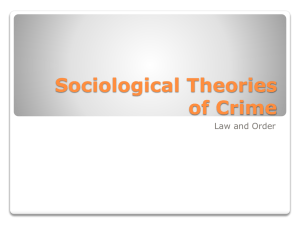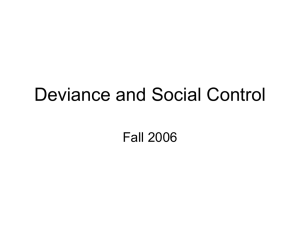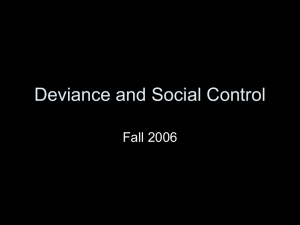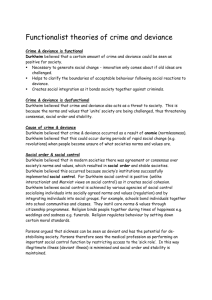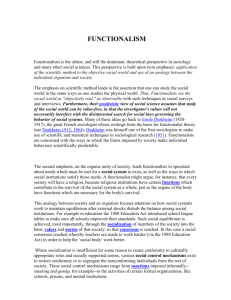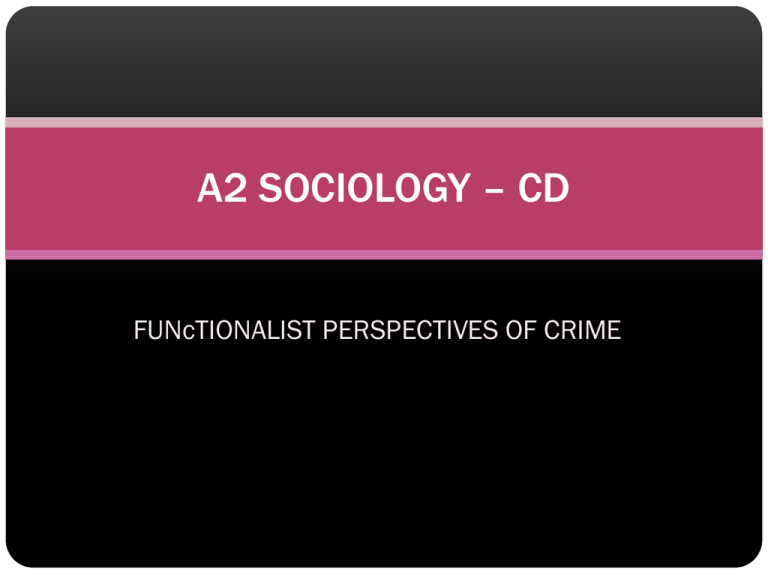
A2 SOCIOLOGY – CD
FUNcTIONALIST PERSPECTIVES OF CRIME
LEARNING OUTCOMES OF THE TOPIC
You will be able to ...
1. Identify and define the functionalist perspectives on
crime including the functions of crime,
2. Identify and define the concept of strain and its role
in explaining deviance,
3. Identify and define the differences between different
strain and subcultural theories,
4. Apply and evaluate the functionalist, strain and
subcultural theories of crime and deviance
What do you think ?
How could the functionalist
perspectives be applied to
crime?
A quick introduction...
http://www.youtube.com/watch?v=XU-nWtmXnKE
What key messages can be identified from the
video ?
Durkheim functionalist theory
Functionalism sees society as based on value
consensus thus seeing its members sharing a
culture,
Culture can be summarise by a set of values and
norms which help create social solidarity thus
binding individuals together,
In order to achieve social solidarity 2 processes
must occur:
Socialisation,
Social control
Inevitability of crime
What can you make of the
title?
Justify your answer
Inevitability of crime
Functionalist on one hand see crime as destabilising
to society but for Durkheim (1893) crime was seen
as inevitable an integral part of all healthy societies,
Durkheim believed that they were two specific
reasons why crime and deviance are found in all
societies:
1. Not everyone is equally socialised into the shared
norms and values,
2. The diversity of lifestyles and values in modern and
complex societies means different groups might
develop their own subcultures with distinctive norms
and values
Inevitability of crime
Durkheim believes that in modern societies there is
a general tendency towards anomie or normalness,
Anomie is when the rules governing behaviour
become weaker and less clear cut,
Anomie can be explained through the complexity of
the division of labour which leads individuals
becoming increasingly different from one another,
This diversity means that the shared culture or
collective conscience is weakened and this results
in higher levels of crime and deviance.
Positive functions of crime
Can you think of any positive
functions to crime ?
Boundary maintenance
Crime produces a reaction from society uniting its
members in condemnation of the wrong doer and
reinforcing their commitment to the shared norms
and values.
i.e. – crackdown on downloading or sexual offences
against children,
Durkheim believed that this explains the concept of
punishment by reaffirming society’s shared rules
and reinforce social solidarity.
Adaptation and change
Durkheim believes that all change starts with an act
of deviance,
Deviance can be seen as a way change existing
norms and values which will initially be seen as
deviant ,
i.e. - the hippy movement back in the 60s-70s was
initially seen as deviant due to their openness to
sex, love, and drug taking
Adaptation and change continued ...
Durkheim also believed that neither high nor low
level of crime is desirable as each of those signals a
malfunctioning society:
1. Too much will eventually tear the bonds of society
apart (terrorism),
2. Too little means that society is repressing and
controlling its members too much stifling individual
freedom and preventing change
Other functions of crime ...
Davis (1961) – argues that prostitution for example acts
as a safety valve for the release of men's frustration,
Polsky (1967) – argues that pornography safely
channels a variety of desires away from the alternatives
such as adultery,
Cohen (1955) – argues that deviance acts as a warning
that an institution is not functioning properly,
Erikson (1966) – believes that the belief that there is a
positive function to society means that society is
organise in order to accommodate crime and deviance
Have a think ....
How could you
criticise the
functionalist
perspective of crime
and deviance?
Criticism
Durkheim fails to offer any way of knowing how
much is the right amount of needed deviance,
Functionalist believe in crime and deviance as
having a function it doesn't actually mean that
society will create CD in order to strengthen
solidarity,
The functionalist fail to look at the way it might
affect others
Homework
In preparation for next lesson read the article by
Merton on the Strain Theory and the concept of
Anomie.
Make sure you summarise the article by noting
down in a bullet point format the key points of the
articles
You must consider the aim of the article, the
message that the author is bringing across and the
conclusions made by the author
Recipe Time
Students have to write a recipe
of the lesson (or their learning).
Can be a good way to narrativize
the lesson and so help recall.
Could develop by asking for a
dramatic (or genre-specific) recipe
of the lesson

